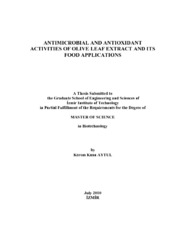Please use this identifier to cite or link to this item:
https://hdl.handle.net/11147/3030Full metadata record
| DC Field | Value | Language |
|---|---|---|
| dc.contributor.advisor | Korel, Figen | - |
| dc.contributor.author | Aytul, Kerem Kaan | - |
| dc.date.accessioned | 2014-07-22T13:50:44Z | |
| dc.date.available | 2014-07-22T13:50:44Z | |
| dc.date.issued | 2010 | - |
| dc.identifier.uri | http://hdl.handle.net/11147/3030 | - |
| dc.description | Includes bibliographical references (leaves: 82-89) | en_US |
| dc.description | Text in English; Abstract: Turkish and English | en_US |
| dc.description | xiii, 89 leaves | en_US |
| dc.description | Thesis (Master)--Izmir Institute of Technology, Biotechnology, Izmir, 2010 | en_US |
| dc.description.abstract | In this study, aqueous/ethanol extract of olive leaves (OLE) was examined for its antimicrobial and antioxidant activities and its possible food applications. In the first part of the study, relative antioxidant capacity and total phenol content of the extract were determined and found as 966 .g ascorbic acid eq./mg and 197.42 mg GAEq/g sample, respectively. In the second part, microdilution assays were conducted by 96 well plate for OLE to find minimum inhibition concentration (MIC) against Gram (+) and Gram (-) bacteria. The most susceptible bacteria were Escherichia coli, Listeria innocua and Staphylococcus carnosus. In the third part OLE was applied to raw beef cubes with 1%, 2% and 3% (v/w) concentrations to examine its antimicrobial and antioxidant effects. The results clearly indicated that usage of 2% and 3% OLE had the beneficial effect in controlling the microbial load, total viable and coliform counts, of beef cubes during 9 days of storage at 4 C. The 2% OLE treatment applied to beef cubes also delayed the oxidative deterioration compared to the other samples. As the last part of the study, 300 ppm OLE was applied to sardine (Sardina pilchardus) fillets as a marinade component. Results indicated that OLE was effective in controlling microbial load of sardine fillets and also delayed the oxidative deterioration and total volatile base nitrogen formation in the fillets during marination process. | en_US |
| dc.language.iso | en | en_US |
| dc.publisher | Izmir Institute of Technology | en_US |
| dc.publisher | Izmir Institute of Technology | en_US |
| dc.rights | info:eu-repo/semantics/openAccess | en_US |
| dc.subject.lcsh | Plant biotechnology | en |
| dc.subject.lcsh | Antioxidants | en |
| dc.subject.lcsh | Anti-infective agents | en |
| dc.title | Antimicrobial and Antioxidant Activities of Olive Leafextract and Its Food Applications | en_US |
| dc.type | Master Thesis | en_US |
| dc.institutionauthor | Aytul, Kerem Kaan | - |
| dc.department | Thesis (Master)--İzmir Institute of Technology, Bioengineering | en_US |
| dc.relation.publicationcategory | Tez | en_US |
| dc.identifier.wosquality | N/A | - |
| dc.identifier.scopusquality | N/A | - |
| item.openairecristype | http://purl.org/coar/resource_type/c_18cf | - |
| item.cerifentitytype | Publications | - |
| item.fulltext | With Fulltext | - |
| item.languageiso639-1 | en | - |
| item.grantfulltext | open | - |
| item.openairetype | Master Thesis | - |
| Appears in Collections: | Master Degree / Yüksek Lisans Tezleri | |
Files in This Item:
| File | Description | Size | Format | |
|---|---|---|---|---|
| T000831.pdf | MasterThesis | 1.33 MB | Adobe PDF |  View/Open |
CORE Recommender
Page view(s)
288
checked on Apr 28, 2025
Download(s)
508
checked on Apr 28, 2025
Google ScholarTM
Check
Items in GCRIS Repository are protected by copyright, with all rights reserved, unless otherwise indicated.